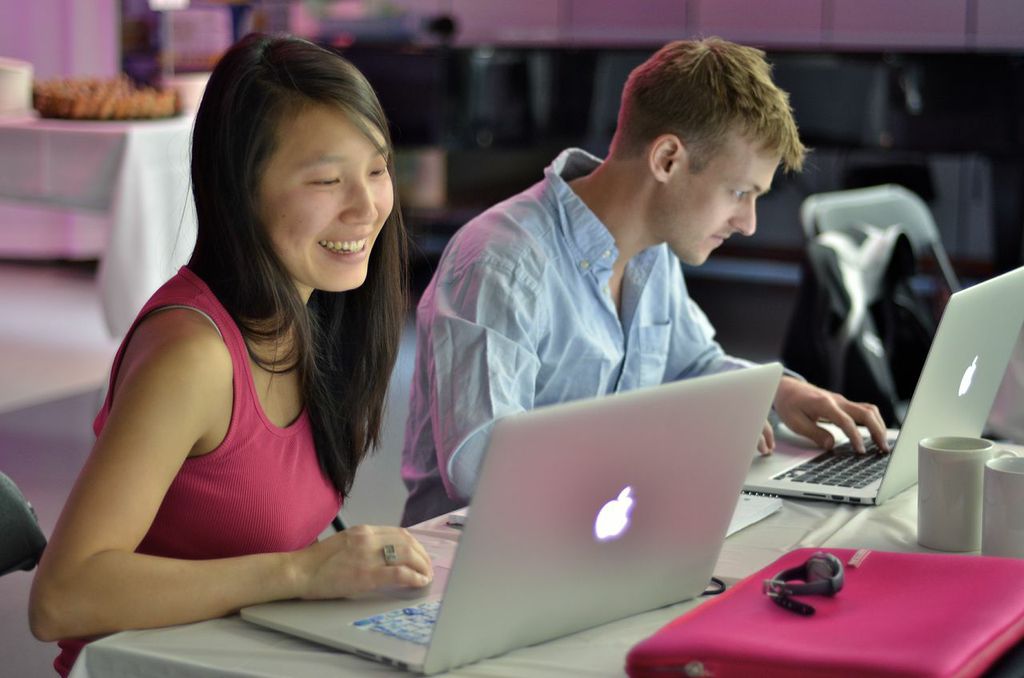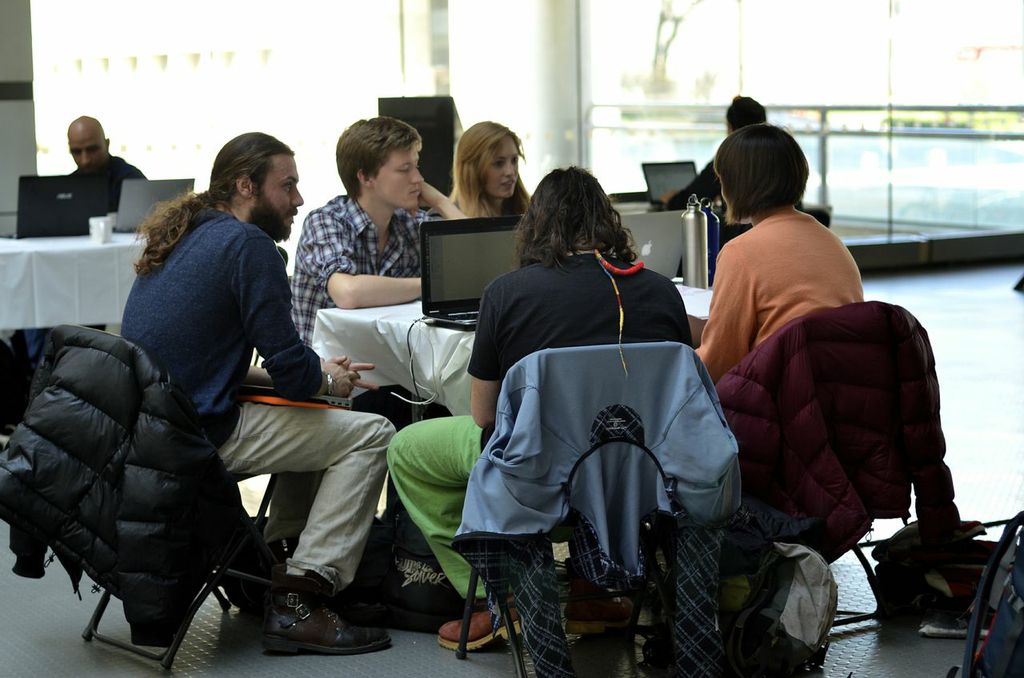MIT Clean Earth Hackathon Breaks Convention to Foster Innovative Ideas for Industry
Winning Teams Combined Talents to Solve Real Sustainability Challenges
New ideas often are born out of frustration or need to shake-up the status quo. Collaboration further enhances idea generation through shared insights, experiences, and ingenuity. Add to the mix a sense of urgency, and entrepreneurial minds quickly begin to improve lives, protect the earth, and shape new global economies.
MIT’s Civil and Environmental Engineering (CEE) department in collaboration with Sustainability@MIT recently held its first Clean Earth Hackathon to encourage just this sort of creative disruption. It brought the MIT and non-MIT communities together to focus on real-world environmental challenges. Students and professionals alike converged on campus to meet, share, and brainstorm new opportunities for industry that can be put to use immediately.
 The hackathon, sponsored by the department of Civil and Environmental Engineering (CEE), and the Student Activity Office was held, appropriately, over Earth Day weekend, on April 17-19, 2015. Typically, hackathons allow participants to pick their own projects, but the Clean Earth Hackathon instead engaged with public, private and non-private organizations to identify a slate of challenges. Eight companies and organizations—including the consulting firm McKinsey, waste recycler Casella, research and environmental consulting group, the Rocky Mountain Institute, and the Massachusetts Bay Transportation Authority (MBTA)—were among the entities invited to challenge the 70+ participants to solve their organization’s most pressing real-world sustainability problems.
The hackathon, sponsored by the department of Civil and Environmental Engineering (CEE), and the Student Activity Office was held, appropriately, over Earth Day weekend, on April 17-19, 2015. Typically, hackathons allow participants to pick their own projects, but the Clean Earth Hackathon instead engaged with public, private and non-private organizations to identify a slate of challenges. Eight companies and organizations—including the consulting firm McKinsey, waste recycler Casella, research and environmental consulting group, the Rocky Mountain Institute, and the Massachusetts Bay Transportation Authority (MBTA)—were among the entities invited to challenge the 70+ participants to solve their organization’s most pressing real-world sustainability problems.
The four winning teams were each awarded $1,000 and selected from among four broad challenge areas: Natural Resource Management, Environmentally-Conscious Design, Mobility in the Modern World, and Refueling the Next Generation.
Ready, Set, Go
 Business Development Manager Liza Casella of New England-based Casella Waste Systems, a presenter and judge, explained that glass is a big component of her company’s recycling stream. Glass today, however, represents a very low value, high cost product in a curbside recycling environment. She and the other judges awarded a prize to Team Gramber for its scalable solution that helps evaluate the risk and reward of using a glass imploder to refurbish glass waste and produce fiberglass and concrete.
Business Development Manager Liza Casella of New England-based Casella Waste Systems, a presenter and judge, explained that glass is a big component of her company’s recycling stream. Glass today, however, represents a very low value, high cost product in a curbside recycling environment. She and the other judges awarded a prize to Team Gramber for its scalable solution that helps evaluate the risk and reward of using a glass imploder to refurbish glass waste and produce fiberglass and concrete.
“This is the kind of innovative thinking we were hoping to spark with our challenge,” said Casella. “A solution that my company can begin working with right away.”
CEE Department Head Markus Buehler said the idea of the hackathon came directly from students last year during his Town Hall meetings. Galvanized by MIT CEE doctoral students Hanny Rivera and Jessica Bryant, the coordinating committee spent much of the school year targeting the right industry and government representatives to help frame the session.
“Teams organized themselves around complementary skills and talents,” said Buehler. “Their solutions epitomized what ‘Big Engineering’ is all about—producing large-scale impact on people and sustainability, covering a spectrum of activities from environment to systems to infrastructure. Our new 1-ENG undergraduate program trains students in this mindset, so it was natural that the hackathon build upon it.”
Course 1 PhD candidate David Hagan said he was incented to give up his weekend to hack alongside a friend on a real-world challenge.
“My team included someone from Harvard, my fellow Kroll group member Mark Goldman, and even an MIT alumnus who runs his own business tech solutions company,” said Hagan. “Although we didn’t win, we helped reimagine, recode, and refine the MassOTA’s public online tool known as the Energy and Materials Flow and Cost Tracker. The agency’s goal was to leverage crowdsourcing to finish this four-year-old app, but the tool really needed some remedial work to interest and draw others in.”
“I had great professors when I earned my doctorate at MIT,” said Mohan Venkataramana CH ‘86, the MIT alum on Hagan’s team. “I’m here to pay it forward by offering my real world experiences and business skills. In return, I enjoy learning from the students, too.”
 Some people chose to work on a project that overlapped two or more of the four challenge areas. For instance, McKinsey Consulting challenged the teams to unlock the value of the ‘Circular Economy’ by bringing products, materials or components back into the economy.
Some people chose to work on a project that overlapped two or more of the four challenge areas. For instance, McKinsey Consulting challenged the teams to unlock the value of the ‘Circular Economy’ by bringing products, materials or components back into the economy.
Working alone, clean energy professional and Babson College MBA, Adam Ostaszewski, studied the U.S. craft brewing industry and created a natural resources management tool that can help brewers make better informed decisions about environment impacts on business economics. One of his recommendations was encouraging the “canned craft beer revolution”–substituting environmentally-conscious aluminum cans for glass beer bottles—potentially saving the earth while improving profits.
Future Event
Rivera and Bryant said they are considering moving the Clean Earth Hackathon to the beginning of the school year in the fall. They believe it might help students better prepare for and conceptualize proposals for the global MIT IDEAS Global Challenge and other startup contests that run through the school year.
Clean Earth Hackathon Spring 2015 Winners
Team “Gramber” won for its proposal of innovative sustainable solutions for glass recycling and reuse by Casella LLC. Members included Anna Cheimets, Olivia Hentz, Qifang Bao, and Brendan Smith.
Team “Cosmopolitan” suggested multiple ways to help the MassDOT better understand cycling movements in the Commonwealth and help it reach its goal of tripling the amount of travel by walking, biking and riding the MBTA by 2030. The team offered infrastructure and systems solutions, including the creation of a new app bikers could use to record their movements which could be anonymized for research and planning. The team consisted of Leo Blondel, Clara Nicolai, Raphaël Tackx, Finn Stirling, and Amy Jobe.
Team “Patagonia Efficiency REV” proposed a sustainable solution for the Patagonia Conservancy, a new national park in Chile, to be fossil fuel independent. One of the team’s innovative suggestions was for the park to store hydrogen in the off-season for use during peak times. Participants included Evgeny Logvinov, Rachit Kansal, and Payal Loungani.
Team “CoalMap” won for its interactive map that evaluates cost-effectiveness of closing down U.S. coal plants. The team created a dynamic application that tracks each plant’s return on investment for switching to a more sustainable energy source. Participants were David Borrelli, Fanni Fan, Joel Jean, and Tony Wu.

